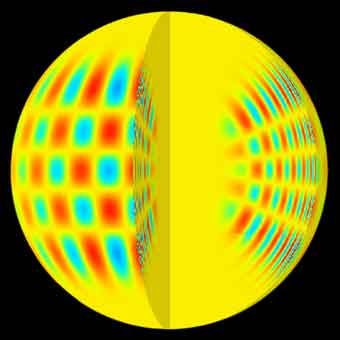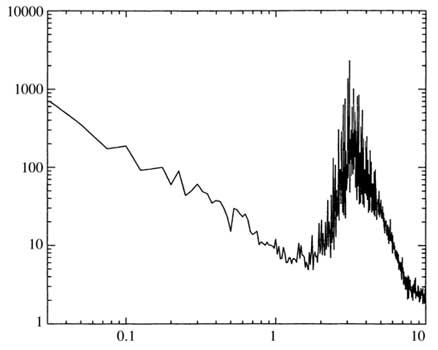A computer-generated image showing the pattern of a p-mode solar acoustic oscillation both in the interior and on the surface of the sun. (l=20, m=16 and n=14.) Note that the increase in the speed of sound as waves approach the center of the sun causes a corresponding increase in the acoustic wavelength. Helioseismology is the study of the propagation of pressure waves in the Sun. Unlike seismic waves on earth, solar waves have practically no shear component (s-waves). Solar pressure waves are generated by the turbulence in the convection zone, near the surface of the sun, and certain frequencies are amplified by constructive interference. In other words, the turbulence "rings" the sun like a bell. The acoustic waves are transmitted to the outer photosphere of the sun, which is where the light emitted by the sun is generated. The acoustic oscillations are detectable on almost any time series of solar images, but are best observed by measuring the doppler shift of photospheric absorption lines. Changes in the propagation of pressure waves through the Sun reveal inner structures and allows astrophysicists to develop extremely detailed profiles of the interior conditions of the Sun. Helioseismology was able to rule out the possibility that the solar neutrino problem was due to incorrect models of the interior of the Sun. Features revealed by helioseismology include that the outer convective zone and the inner radiative zone rotate at different speeds to generate the main magnetic field of the Sun, and that the convective zone has "jet streams" of plasma thousands of kilometers below the surface. These jet streams form broad fronts at the equator, breaking into smaller cyclonic storms at high latitudes. Helioseismology can also be used to detect sunspots on the far side of the Sun from Earth. Keep in mind that despite the name, helioseismology is the study of solar pressure waves and not solar seismic activity - there is no such thing. The name is derived from the similar practice of studying terrestrial seismic waves to determine the composition of the Earth's interior. The science can be compared to asteroseismology, which considers the propagation of sound waves in stars. * Animated picture of a Moreton wave
Low-resolution solar oscillation spectrum taken by the GOLF instrument between 19 February and 25 March 1996. The horizontal axis is frequency in millihertz, or thousandths of a hertz (mHz), the vertical axis is power density. The "5-minute oscillation" is the series of p-mode lines on the right between about 2 and 7 mHz. Solar oscillations are essentially divided up into three categories, based on the restoring force that drives them: acoustic, gravity, and surface-gravity wave modes. * p-mode or acoustic waves have pressure as their restoring force, hence the name "p-mode". Their dynamics are determined by the variation of the speed of sound inside the sun. p-mode oscillations have frequencies > 1 mHz and are very strong in the 2-4 mHz range, where they are often referred to as "5-minute oscillations". (Note: 5 minutes per cycle is 1/300 cycles per second = 3.33 mHz.) P-modes at the solar surface have amplitudes of hundreds of kilometers and are readily detectable with Doppler imaging or sensitive spectral line intensity imaging. * g-mode or gravity waves are density waves which have gravity (negative buoyancy of displaced material) as their restoring force, hence the name "g-mode". The g-mode oscillations are low frequency waves (0-0.4 mHz). They are confined to the interior of the sun below the convection zone (which extends from 0.7-1.0 solar radius), and are practically inobservable at the surface. The restoring force is caused by adiabatic expansion: in the deep interior of the Sun, the temperature gradient is weak, and a small packet of gas that moves (for example) upward will be cooler and denser than the surrounding gas, and will therefore be pulled back to its original position; this restoring force drives g-modes. In the solar convection zone, the temperature gradient is slightly greater than the adiabatic lapse rate, so that there is an anti-restoring force (that drives convection) and g-modes cannot propagate. The g modes are evanescent through the entire convection zone, and are thought to have residual amplitudes of only millimeters at the photosphere. Since the '80s, there have been several claims of g-mode detection, none of which have been confirmed. In 2007, another g-mode detection was claimed using the GOLF data [1][2]. These latter results are neither confirmed nor part of a general consensus among the helioseismic community. * f-mode or surface gravity waves are also gravity waves, but occur at or near the photosphere, where the temperature gradient again drops below the adiabatic lapse rate. Helioseismic dating The age of the sun can be inferred with helioseismic studies. This method provides verification of the age of the solar system gathered from the radiometric dating of meteorites.[1] References 1. ^ A. Bonanno, H. Schlattl, L. Paternò (2002). "The age of the Sun and the relativistic corrections in the EOS". Astronomy and Astrophysics. Links * Lecture Notes on Stellar Oscillations by Jørgen Christensen-Dalsgaard o Non-technical description of helio- and asteroseismology * Laurent Gizon and Aaron C. Birch, "Local Helioseismology", Living Rev. Solar Phys. 2 (2005) 6 online article * Scientists Issue Unprecedented Forecast of Next Sunspot Cycle National Science Foundation press release, March 6, 2006 Satellite instruments * GOLF Ground-based instruments * BiSON See also * Asteroseismology Retrieved from "http://en.wikipedia.org/"
|
|

